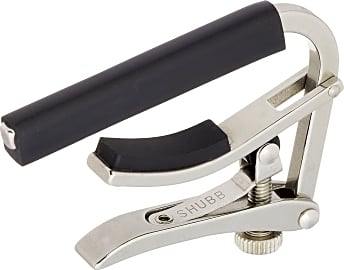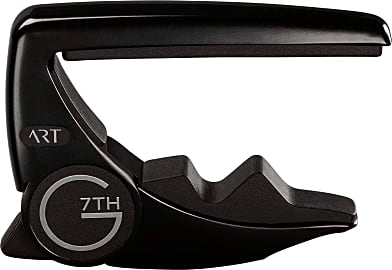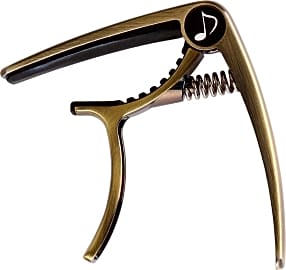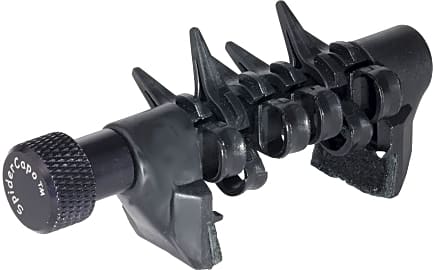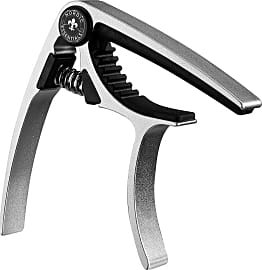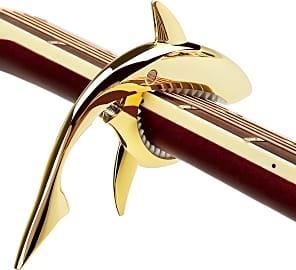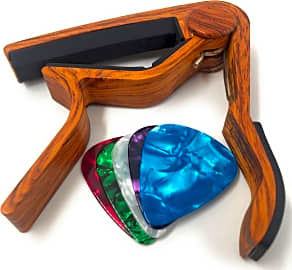The 10 Best Capos

This wiki has been updated 34 times since it was first published in October of 2016. A capo is a handy little tool that can raise the pitch of a fretted instrument so musicians can play in a different key using the same fingerings as playing open. They accomplish this by shortening the length of all the strings, essentially creating a new nut. Performers commonly place them on guitars, banjos, and mandolins to add a bit more versatility to their style. When users buy our independently chosen editorial recommendations, we may earn commissions to help fund the Wiki.
Editor's Notes
April 03, 2020:
Even though they are relatively inexpensive, we've ultimately opted to remove the Kliq K-PO, the xGuitarx X3, and the UGY High-Performance. They are somewhat more likely to break than the competition, which is frustrating — especially when you're in the middle of a performance. If you're strapped for cash, consider instead the Wingo Rosewood, which comes with five picks, or the Donner DC-2. These are incredibly simple, but they'll get the job done and leave room in the budget for other accessories, like a guitar bag.
Musicians with more demanding needs might instead consider the Kyser Quick Change, a perennially popular choice offered in a range of colors. It lives up to its name by providing fast adjustments, and it's lightweight and durable, to boot. If you want more control over the tension, and don't mind taking a little more time with adjustments, there's the Paige Original for six-string acoustics. A screw-down model, it can be stored behind the nut when not in use. And speaking of adjustments, we've added the Creative Tunings SpiderCapo. It allows you to fine tune for each string individually, which makes it endlessly versatile, but also somewhat finicky. If you're a songwriter looking for some inspiration, though, it can be a fun tool for getting the creative juices flowing.
Special Honors
Thalia African Zebrawood The Thalia African Zebrawood costs a little more than many users will want to spend, but even a quick glance at its attractive wood and sleek finish will tell you that if you have the budget for it, it's a worthy investment. It's not just a pretty face, either; it comes with 14 fretpads, so there is bound to be one that fits just right. thaliacapos.com
Elliott Guitar Capo The Elliott Guitar Capo combines the durability of metal with the soft protection of leather for a model that is both safe and long-lasting. Boasting a push-button top bar that releases quickly, it can be engraved to your specifications, which makes it a great option for personalized gift-giving. elliottcapo.com
Customized Laser Works Custom The Customized Laser Works Custom is just that, a model that can be engraved for personalization the recipient is sure to love. The capo itself is a simple clamp-style with a sturdy aluminum construction, conveniently offered in several colors. etsy.com
How Does A Capo Work?
Without getting too technical, a capo allows a guitarist to use open chord shapes to play in keys that would require a barre chord on a capo-less guitar.
One of the most common guitar accessories, a capo is a clamp-like device that raises the pitch of a guitar’s strings. The device, which is pronounced with a long “a” sound like "cape-oh," works by applying pressure to all of the strings evenly at the fret on which the user places it. This effectively makes a new nut, although technically the capo must work in addition to the existing nut, since the former doesn’t have grooves for the strings as does the latter.
The pitch sounded by each string, once shortened by the capo, becomes higher by a half a step for each fret. So, if you place the capo at the first fret, the E of the first and sixth strings in standard tuning becomes an F, which is the note that’s one half step (also called semitone) higher. You could achieve this same type of change by turning the guitar’s pegs to manually change each string’s pitch, a process commonly called tuning up or tuning down. A capo, however, gives results much faster and with less hassle.
The handy capo offers guitarist several specific benefits. For one, thanks to a shorter string length, the guitar will sound brighter, perhaps giving a sound more like a mandolin. For another, a capo makes it easy for a guitarist to quickly change the key of a song to suit a singer’s vocal range. Playing around with a capo can be fun, too, as it’s a great tool for experimentation.
Perhaps one of the more prominent reasons guitarists pick up a capo, though, is to make playing in difficult keys a little bit easier. For example, many newer guitarists struggle with barre chords, which require pressing down multiple strings with one finger in a bar position, as opposed to open chords, where a finger only has to press one string at a time. Without getting too technical, a capo allows a guitarist to use open chord shapes to play in keys that would require a barre chord on a capo-less guitar. That’s because even though the capo raises the pitch of the strings, the pitches do not change relative to one another. Thus, open chord shapes still produce chords, just in a different key.
Tips For Capo Use
A capo is a simple device, as it’s little more than a clamp or elastic strap with some padding, usually rubber, that provides pressure to the guitar strings. Although it seems simple enough to use, following a few dos and don’ts will make your time more productive and help you protect your valuable instrument.
First, for the best results, you’ll want to tune your guitar before you put the capo on and after you remove it.
First, for the best results, you’ll want to tune your guitar before you put the capo on and after you remove it. Even if you’re gentle, it’s possible, even probable, that you’ll change the strings’ tension when adjusting the capo. Be sure you don’t slide a standard capo up and down the fret over the strings; always gently unclamp it, then slide it or move it. If your guitar is in tune before you add the capo, and it goes out once the capo is on, check and see whether you’ve inadvertently pushed the strings sideways. Even the smallest amount can make a difference.
Second, make sure that you’re placing the capo in the right place, which will help eliminate tuning issues. Most guitar teachers and experts agree that the best position for the capo is directly behind the fret, not on top of it or midway between two frets. Essentially, the capo will mimic good finger position; you wouldn’t barre on top of a fret, for instance, so you shouldn’t do so with a capo, either.
Next, remove the capo when you finish playing. Leaving the capo on the strings for extended periods of time could bend your strings or reduce a fret’s lifespan. If you’re afraid you’ll lose the capo, you can clip it on the headstock so it’s easily available when you’re ready to play.
Finally, and it should hopefully go without saying, make sure that the capo is clean and in good condition. Time can cause gunk to build up on the rubber padded part that rests on the strings, as can ample use. Using a dirty or cracked capo could hurt your guitar’s neck or strings, however, and you’ll end up with more trouble in the long run than you’d have by simply replacing it.
A Brief History Of The Capo
Although most historians agree that various capo devices were available as early as the 1600s, the first capo as we know it was patented in 1850 by James Ashborn. Born in England, Ashborn emigrated to the United States in the 1830s and set up a guitar-making shop. By all accounts, this shop was successful, probably due to both the large amount of guitars he was able to produce, as well as his innovative designs. His instruments were always of excellent quality and receive high regard, even today.
These let users explore a whole host of alternate tunings or adjust the tuning without entirely losing the fuller sound of un-shortened strings.
That first capo patent paved the way for many others — over 130 to date, in fact. One of the most important patents was granted in 1931 to W.H. Russel. This was the elastic capo, a model that guitar players still enjoy today. A second significant change to the capo market happened in the 1970s, when the Shubb side-clamp screw-adjustable capo became available. These were a big success, and Shubb remains one of the top choices for capos.
Capos have continued to change and evolve since the 1970s. There are glider capos that can roll up and down the fret board, novelty capos shaped like animals, clamp capos, deluxe capos, quick-change capos, and more. One type that’s receiving more and more attention is the partial capo, which lets the user shorten only three, four, or five strings, instead of all six. These let users explore a whole host of alternate tunings or adjust the tuning without entirely losing the fuller sound of un-shortened strings.



